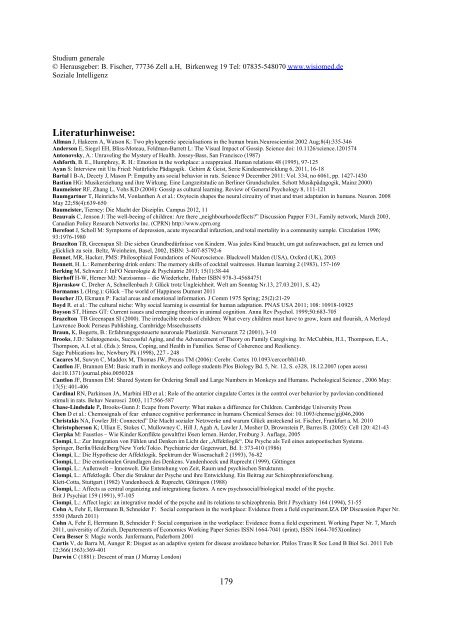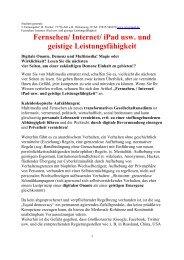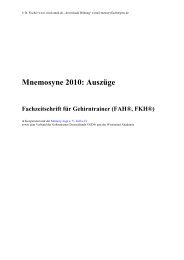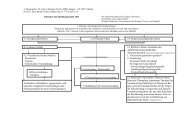16. Soziale intelligenz, was ist das? (Stichpunkte ... - WissIOMed
16. Soziale intelligenz, was ist das? (Stichpunkte ... - WissIOMed
16. Soziale intelligenz, was ist das? (Stichpunkte ... - WissIOMed
Sie wollen auch ein ePaper? Erhöhen Sie die Reichweite Ihrer Titel.
YUMPU macht aus Druck-PDFs automatisch weboptimierte ePaper, die Google liebt.
Studium generale<br />
© Herausgeber: B. Fischer, 77736 Zell a.H, Birkenweg 19 Tel: 07835-548070 www.wisiomed.de<br />
<strong>Soziale</strong> Intelligenz<br />
Literaturhinweise:<br />
Allman J, Hakeem A, Watson K: Two phylogenetic specialisations in the human brain.Neuroscient<strong>ist</strong> 2002 Aug;8(4):335-346<br />
Anderson E, Siegel EH, Bliss-Moteau, Feldman-Barrett L: The Visual Impact of Gossip. Science doi: 10.1126/science.1201574<br />
Antonovsky, A.: Unraveling the Mystery of Health. Jossey-Bass, San Francisco (1987)<br />
Ashforth, B. E., Humphrey, R. H.: Emotion in the workplace: a reappraisal. Human relations 48 (1995), 97-125<br />
Ayan S: Interview mit Uta Fried: Natürliche Pädagogik. Gehirn & Ge<strong>ist</strong>, Serie Kindesentwicklung 6, 2011, 16-18<br />
Bartal I B-A, Decety J, Mason P: Empathy ans social behavior in rats. Science 9 December 2011: Vol. 334, no 6061, pp. 1427-1430<br />
Bastian HG: Musikerziehung und ihre Wirkung. Eine Langzeitstudie an Berliner Grundschulen. Schott Musikpädagogik, Mainz 2000)<br />
Baume<strong>ist</strong>er RF, Zhang L, Vohs KD (2004): Gossip as cultural learning. Review of General Psychology 8, 111-121<br />
Baumgartner T, Heinrichs M, Vonlanthen A et al.: Oxytocin shapes the neural circuitry of trust and trust adaptation in humans. Neuron. 2008<br />
May 22;58(4):639-650<br />
Baume<strong>ist</strong>er, Tierney: Die Macht der Disziplin. Campus 2012, 11<br />
Beauvais C, Jenson J: The well-beeing of children: Are there „neighbourhoodeffects” Discussion Papper F/31, Family network, March 2003,<br />
Canadian Policy Research Networks Inc. (CPRN) http://www.cprn.org<br />
Berefoot J, Scholl M: Symptoms of depression, acute myocardial infarction, and total mortality in a community sample. Circulation 1996;<br />
93:1976-1980<br />
Brazelton TB, Greenspan SI: Die sieben Grundbedürfnisse von Kindern. Was jedes Kind braucht, um gut aufzuwachsen, gut zu lernen und<br />
glücklich zu sein. Beltz, Weinheim, Basel, 2002, ISBN: 3-407-85792-6<br />
Bennet, MR, Hacker, PMS: Philosophical Foundations of Neuroscience. Blackwell Malden (USA), Oxford (UK), 2003<br />
Bennett, H. L.: Remembering drink orders: The memory skills of cocktail waitresses. Human learning 2 (1983), 157-169<br />
Berking M, Schwarz J: InFO Neurologie & Psychiatrie 2013; 15(1):38-44<br />
Bierhoff H-W, Herner MJ: Narzissmus – die Wiederkehr, Huber ISBN 978-3-45684751<br />
Bjornskow C, Dreher A, Schnellenbach J: Glück trotz Ungleichheit. Welt am Sonntag Nr.13, 27.03.2011, S. 42)<br />
Bormanns L (Hrsg.): Glück –The world of Happiness Dumont 2011<br />
Boucher JD, Ekmann P: Facial areas and emotional information. J Comm 1975 Spring; 25(2):21-29<br />
Boyd R. et al.: The cultural niche: Why social learning is essential for human adaptation. PNAS USA 2011; 108: 10918-10925<br />
Boyson ST, Himes GT: Current issues and emerging theories in animal cognition. Annu Rev Psychol. 1999;50:683-705<br />
Brazelton TB Greenspan SI (2000). The irreducible needs of children: What every children must have to grow, learn and flourish, A Merloyd<br />
Lawrence Book Perseus Publishing, Cambridge Mssechussetts<br />
Braun, K, Bogerts, B.: Erfahrungsgesteuerte neuronale Plastizität. Nervenarzt 72 (2001), 3-10<br />
Brooks, J.D.: Salutogenesis, Successful Aging, and the Advancement of Theory on Family Caregiving. In: McCubbin, H.I., Thompson, E.A.,<br />
Thompson, A.I. et al. (Eds.): Stress, Coping, and Health in Families. Sense of Coherence and Resiliency.<br />
Sage Publications Inc, Newbury Pk (1998), 227 - 248<br />
Cacares M, Suwyn C, Maddox M, Thomas JW, Preuss TM (2006): Cerebr. Cortex 10.1093/cercor/bhl140.<br />
Cantlon JF, Brannon EM: Basic math in monkeys and college students Plos Biology Bd. 5, Nr. 12, S. e328, 18.12.2007 (open acess)<br />
doi:10.1371/journal.pbio.0050328<br />
Cantlon JF, Brannon EM: Shared System for Ordering Small and Large Numbers in Monkeys and Humans. Pschological Science , 2006 May:<br />
17(5): 401-406<br />
Cardinal RN, Parkinson JA, Marbini HD et al.: Role of the anterior cingulate Cortex in the control over behavior by pavlovian conditioned<br />
stimuli in rats. Behav Neurosci 2003, 117:566-587<br />
Chase-Lindsdale P, Brooks-Gunn J: Ecape from Poverty: What makes a difference for Children. Cambridge University Press<br />
Chen D et al.: Chemosignals of fear enhance cognitive performance in humans Chemical Senses doi: 10.1093/chemse/gij046,2006<br />
Chr<strong>ist</strong>akis NA, Fowler JH: Connected” Die Macht sozialer Netzwerke und warum Glück ansteckend <strong>ist</strong>. Fischer, Frankfurt a. M. 2010<br />
Chr<strong>ist</strong>opherson K; Ullian E, Stokes C, Mullowney C, Hill J, Agah A, Lawler J, Mosher D, Brownstein P, Barres B. (2005): Cell 120: 421-43<br />
Cierpka M: Faustlos – Wie Kinder Konflikte gewaltfrei lösen lernen. Herder, Freiburg 3. Auflage, 2005<br />
Ciompi, L.: Zur Integration von Fühlen und Denken im Licht der „Affektlogik“. Die Psyche als Teil eines autopoetischen Systems.<br />
Springer, Berlin/Heidelberg/New York/Tokio. Psychiatrie der Gegenwart, Bd. I: 373-410 (1986)<br />
Ciompi, L.: Die Hypothese der Affektlogik. Spektrum der Wissenschaft 2 (1993), 76-82<br />
Ciompi, L.: Die emotionalen Grundlagen des Denkens. Vandenhoeck und Ruprecht (1999), Göttingen<br />
Ciompi, L.: Außenwelt – Innenwelt. Die Entstehung von Zeit, Raum und psychischen Strukturen.<br />
Ciompi, L.: Affektlogik. Über die Struktur der Psyche und ihre Entwicklung. Ein Beitrag zur Schizophrenieforschung.<br />
Klett-Cotta, Stuttgart (1982) Vandenhoeck & Ruprecht, Göttingen (1988)<br />
Ciompi, L.: Affects as central organizing and integrationg factors. A new psychosocial/biological model of the psyche.<br />
Brit J Psychiat 159 (1991), 97-105<br />
Ciompi, L.: Affect logic: an integrative model of the psyche and its relations to schizophrenia. Brit J Psychiatry 164 (1994), 51-55<br />
Cohn A, Fehr E, Herrmann B, Schneider F: Social comparison in the workplace: Evidence from a field experiment.IZA DP Discussion Paper Nr.<br />
5550 (March 2011)<br />
Cohn A, Fehr E, Herrmann B, Schneider F: Social comparison in the workplace: Evidence from a field experiment. Working Paper Nr. 7, March<br />
2011, universitiy of Zurich, Departements of Economics Working Paper Series ISSN 1664-7041 (print), ISSN 1664-705X(online)<br />
Cora Besser S: Magic words. Junfermann, Paderborn 2001<br />
Curtis V, de Barra M, Aunger R: Disgust as an adaptive system for disease avoidance behavior. Philos Trans R Soc Lond B Biol Sci. 2011 Feb<br />
12;366(1563):369-401<br />
Darwin C (1881): Descent of man (J Murray London)<br />
179













